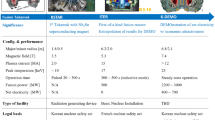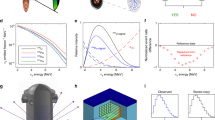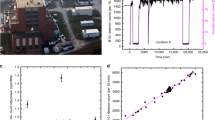Abstract
To assist in the development of nuclear fusion as a viable commercial power source, preparation is underway for the fusion demonstration reactor (DEMO), which will build on the work of ITER, the international experimental fusion reactor. Like other advanced nuclear energy systems, DEMO must satisfy several goals including a high level of public and worker safety, low environmental impact, high reactor availability, a closed fuel cycle and the potential to be economically competitive. Yet there are still large scientific and technological safety gaps between the on-going ITER project and DEMO that will need to be addressed. Here we review international fusion safety research and development relevant to DEMO, following the lessons learned so far from ITER. We identify the main scientific and technological safety gaps, drawing on knowledge from the development of fission energy, in particular Generation IV (Gen-IV) fission reactors. From this survey, we discuss the corresponding implications for the design and operation of DEMO.
This is a preview of subscription content, access via your institution
Access options
Subscribe to this journal
Receive 12 digital issues and online access to articles
$119.00 per year
only $9.92 per issue
Buy this article
- Purchase on Springer Link
- Instant access to full article PDF
Prices may be subject to local taxes which are calculated during checkout



Similar content being viewed by others
References
Life Cycle Greenhouse Gas Emissions of Nuclear Electricity Generation (NREL, 2013); http://go.nature.com/2eZYn62
Chu, S. & Majumdar, A. Opportunities and challenges for a sustainable energy future. Nature 488, 294–303 (2012).
Technology Roadmap: Nuclear Energy (OECD/NEA, 2015); http://go.nature.com/2ezf7Ng
Bigot, B. Pull together for fusion. Nature 522, 149–151 (2015).
Ongena, J., Koch, R., Wolf, R. & Zohm, H. Magnetic-confinement fusion. Nat. Phys. 12, 398–410 (2016).
Luo, D. ITER Implementation and Fusion Energy Research in China KN7 (ISFNT, 2015); http://www.isfnt-12.org/presentations
Qiu, L. et al. A low aspect ratio tokamak transmutation system. Nucl. Fusion 40, 629–633 (2000).
Wu, Y. & FDS Team. Conceptual design of the China fusion power plant FDS-II. Fusion Eng. Des. 83, 1683–1689 (2008).
Wu, Y., Jiang, J., Wang, M., Jin, M. & FDS Team. A fusion-driven subcritical system concept based on viable technologies. Nucl. Fusion 51, 103036 (2011).
Federici, G. et al. Overview of the design approach and prioritization of R&D activities towards an EU DEMO. Fusion Eng. Des. 109–111, 1464–1474 (2016).
Deshpande, S. ITER and Beyond: Indian Perspective KN6 (ISFNT, 2015); http://www.isfnt-12.org/presentations
Yamada, H. et al. Japanese endeavors to establish technological bases for DEMO. Fusion Eng. Des. 109–111 1318–1325 (2016).
Kim, K. Korean Progress on Fusion Research and Future Plan KN2 (ISFNT, 2015); http://www.isfnt-12.org/presentations
Kuteev, B. V. et al. Development of DEMO-FNS tokamak for fusion and hybrid technologies. Nucl. Fusion 55, 073035 (2015).
Kessel, C. E. et al. The fusion nuclear science facility, the critical step in the pathway to fusion energy. Fusion Sci. Technol. 68, 225–236 (2015).
Safety of Nuclear Power Plants: Design, Specific Safety Requirements No. SSR-2/1 (IAEA, 2016); http://go.nature.com/2eDj9VF This IAEA standard establishes requirements applicable to the design of nuclear power plants and elaborates on the safety objectives, safety principles and concepts.
Considerations on the Application of the IAEA Safety Requirements for the Design of Nuclear Power Plants IAEA TECDOC-1791 (IAEA, 2016); http://go.nature.com/2dKoQn4
Duderstadt, J. J. & Hamilton, L. J. Nuclear Reactor Analysis (Wiley, 1976).
Taylor, N. & Elbez-Uzan, J. Preliminary Safety Report (RPrS)_3ZR2NC_v3_0–11 (ITER, 2011). This report mainly covers the description of ITER facility and environment, and preliminary safety demonstration, which was examined by the French Nuclear Safety Authorities for the ITER licensing.
Van Dorsselaere, J. P. et al. Progress of IRSN R&D on ITER safety assessment. J. Fusion Energ. 31, 405–410 (2012).
Guide No. 13: Protection of Basic Nuclear Installations Against External Flooding (ASN, 2013); http://go.nature.com/2eAeDak
Basic Safety Rule 2001–01. Determination of the Seismic Risk for the Safety of Surface Basic Nuclear Installations (ASN, 2001); http://go.nature.com/2d1j7VJ
Stieglitz, R. et al. Aspects of Fusion Safety Considering Fission Regulations (IAEA, 2015); http://go.nature.com/2cQM6xR
Causey, R. A. Hydrogen isotope retention and recycling in fusion reactor plasma-facing components. J. Nucl. Mater. 300, 91–117 (2002).
Bell, M. G. et al. Plasma response to lithium-coated plasma-facing components in the National Spherical Torus Experiment. Plasma Phys. Contr. Fusion 51, 124054 (2009).
Ono, M. Lithium as Plasma Facing Component for Magnetic Fusion Research. Report Number(s) PPPL–4808 (Princeton Plasma Physics Laboratory, 2012).
Ono, M. et al. Recent progress in the NSTX/NSTX-U lithium programme and prospects for reactor-relevant liquid-lithium based divertor development. Nucl. Fusion 53, 113030 (2013).
Wong, C. P. C. & Merrill, B. Use of system code to estimate equilibrium tritium inventory in fusion DT machines, such as ARIES-AT and components testing facilities. Fusion Eng. Des. 89, 1482–1485 (2014).
Humrickhouse, P., Ying, A. & Rapisarda, D. Tritium in DEMO (IAEA, 2015); http://go.nature.com/2dKqJQj
Petrangeli, G. Nuclear Safety (Elsevier Butterworth Heinemann, 2006).
Radiation Dose Limits for Individual Members of the Public. NRC: 10 CFR 20.1301 (NRC, 1991); http://go.nature.com/2en06RF
Classification of Radioactive Waste No. GSG-1 (IAEA, 2009); http://go.nature.com/2dKrwRv
French Act: Sustainable Management of Radioactive Materials and Waste (French, 2006); http://go.nature.com/2eiroqT
Licensing Requirements for Land Disposal of Radioactive Waste. NRC: 10 CFR 61 (NRC, 2015); http://go.nature.com/2cQN4u9
Classification of Radioactive Waste HAD401–04 (Ministry of Environmental Protection of China, 1998).
Alejaldre, C. Lessons Learned in the Safety and Licensing of ITER, 01 (IEA, 2015); http://go.nature.com/2dqDfzY This paper reviews the lessons learned in the safety and licensing of ITER.
Wu, Y. et al. Development strategy and conceptual design of China Lead-based Research Reactor. Ann. Nucl. Energ. 87, 511–516 (2016).
Pamela, J. et al. ITER tritiated waste management by the host state and first lessons learned for fusion development. Fusion Eng. Des. 89, 2001–2007 (2014).
Taylor, N. et al. ITER safety and licensing update. Fusion Eng. Des. 87, 476–481 (2012).
Fundamental Safety Principles No. SF-1 (IAEA, 2006); http://go.nature.com/2dsGbMW
Basic Safety Principles for Nuclear Power Plants 75-INSAG-3 Rev. 1 (IAEA, 1999); http://go.nature.com/2dwSsAK
A Technology Roadmap for Generation IV Nuclear Energy Systems (US DOE, GIF, 2002); http://go.nature.com/2e6nXo8
Generation IV International Forum. Annual Report 2013 (GIF, 2013).
Taylor, N. & Cortes P. Lessons learnt from ITER safety& licensing for DEMO and future nuclear fusion facilities. Fusion Eng. Des. 89, 1995–2000 (2014).
Defence in Depth in Nuclear Safety INSAG-10 (IAEA, 1996); http://go.nature.com/2cQNlwW
Taylor, N. in 26th Symposium on Fusion Engineering (SOFE). Safety and Licensing of Nuclear Facilities for Fusion (IEEE, 2015); http://go.nature.com/2cQNnoG
Risk and Safety Working Group. An Integrated Safety Assessment Methodology (ISAM) for Generation IV Nuclear Systems (GIF, 2011). This paper presents an integrated safety assessment methodology for evaluating the safety of Generation IV nuclear systems.
Pinna, T. et al. Fusion component failure rate database (FCFR-DB). Fusion Eng. Des. 81, 1391–1395 (2006).
Pinna, T. et al. Operating experiences from existing fusion facilities in view of ITER safety and reliability. Fusion Eng. Des. 85, 1410–1415 (2010).
Wu, Y. et al. Summary of the 1st international workshop on environmental, safety and economic aspects of fusion power. Nucl. Fusion 56 127001 (2016).
Proceedings of 1st IAEA Technical Meeting on Fusion Power Plant Safety (IAEA, 2016); http://go.nature.com/2cQOc0y
Wu, Y. The development of high intensity D-T fusion neutron generator HINEG. Int. J. Energ. Res. http://dx.doi.org/10.1002/er.3572 (2016).
Wu, Y. & FDS Team. Conceptual design and testing strategy of a dual functional lithium–lead test blanket module in ITER and EAST. Nucl. Fusion 47, 1533–1539 (2007).
Wu, Y. & FDS Team. Design status and development strategy of China liquid lithium–lead blankets and related material technology. J. Nucl. Mater. 367, 1410–1415 (2007).
Wu, Y. & FDS Team. CAD-based interface programs for fusion neutron transport simulation. Fusion Eng. Des. 84, 1987–1992 (2009).
Wu, Y. & FDS Team. Conceptual design activities of FDS series fusion power plants in China. Fusion Eng. Des. 81, 2713–2718 (2006). This paper presents a series of fusion power plants designed and assessed for the examination of the feasibility and the safety, environmental and economic potential of fusion.
Wu, Y. & FDS Team. Fusion-based hydrogen production reactor and its material selection. J. Nucl. Mater. 386, 122–126 (2009).
Song, Y. T. et al. Concept design of CFETR Tokamak machine. IEEE T. Plasma Sci. 42, 503–509 (2014).
Perrault, D. Safety issues to be taken into account in designing future nuclear fusion facilities. Fusion Eng. Des. 109–111 1733–1738 (2016). This paper gives the IRSN's position on the safety issues which should be considered in the design of future nuclear fusion facilities.
Séropian, C., Barrachin, M., Van Dorsselaere, J. P. & Vola, D. Adaptation of the ASTEC code system to accident scenarios in fusion installations. Fusion Eng. Des. 88, 2698–2703 (2013).
Fischer, U., Bachmann, C., Palermo, I., Pereslavtsev, P. & Villari, R. Neutronics requirements for a DEMO fusion power plant. Fusion Eng. Des. 98, 2134–2137 (2015).
Pereslavtsev, P., Lu, L., Fischer, U. & Bitz, O. Neutronic analyses of the HCPB DEMO reactor using a consistent integral approach. Fusion Eng. Des. 89, 1979–1983 (2013).
Jin, X. Z. et al. Preliminary safety studies for the DEMO HCPB blanket concept. Fusion Eng. Des. 98, 2157–2161 (2015).
Ricapito, I., Ciampichetti, A. & Benamati, G. Pb–17Li/water interaction in DEMO WCLL blanket: water micro-leaks. Fusion Eng. Des. 65, 577–587 (2003).
Carpignano, A. et al. Safety issues related to the intermediate heat storage for the EU DEMO. Fusion Eng. Des. 109–111, 135–140 (2016).
Tobita, K., Federici, G., Okano, K. & The BA DEMO Design Activity Unit. Research and development status on fusion DEMO reactor design under the Broader Approach. Fusion Eng. Des. 89, 1870–1874 (2014).
Rivas, J. C. et al. Safety studies of plasma-wall events with AINA code for Japanese DEMO. Fusion Eng. Des. 109–111, 1653–1657 (2016).
Nakamura, M. Progress in thermohydraulic analysis of accident scenarios of a water-cooled fusion DEMO reactor. In 26th Symposium on Fusion Engineering (IEEE, 2015); http://doi.org/br6v
Kobayashi, K. et al. Studies on the behaviour of tritium in components and structure materials of tritium confinement and detritiation systems of ITER. Nucl. Fusion 47, 1645–1651 (2007).
Someya, Y. et al. Waste management scenario in the hot cell and waste storage for DEMO. Fusion Eng. Des. 89, 2033–2037 (2014).
Nakamura, M. et al. Thermohydraulic responses of a water-cooled tokamak fusion DEMO to loss-of-coolant accidents. Nucl. Fusion 55, 123008 (2015).
Hashizume, H. et al. Overview of fusion engineering in Japan. Fusion Sci. Technol. 68, 201–210 (2015).
Oh, K., Kang, M. S., Heo, G. & Kim, H. C. Safety studies on Korean fusion DEMO plant using integrated safety assessment methodology. Fusion Eng. Des. 89, 2057–2061 (2014).
Oh, K., Kang, M. S., Heo, G. & Kim, H. C. Safety studies on Korean fusion DEMO plant using integrated safety assessment methodology: Part 2. Fusion Eng. Des. 98–99, 2152–2156 (2015).
Kang, M.-s., Lee, S., Lee, H. G. & Heo, G. Gap study on technical standards and quality assurance between ITER and Korean regulation. Fusion Eng. Des. 109–111, 1475–1479 (2016).
Lee, J. H. et al. Thermal-hydraulic analysis of water cooled breeding blanket of K-DEMO using MARS-KS code. Fusion Eng. Des. 98–99, 1741–1746 (2015).
Petti, D. A. et al. Recent accomplishments and future directions in the US fusion safety and environmental program. Nucl. Fusion 47, S427–S435 (2007).
Safety of Magnetic Fusion Facilities: Requirements DOE-STD-6002–96 (DOE, 1996); http://go.nature.com/2eqdtxC
Safety of Magnetic Fusion Facilities: Guidance DOE-STD-6003–96 (DOE, 1996); http://go.nature.com/2epon8y This standard, the first standard of its kind in the fusion community, provides guidance to successfully achieve public and worker safety at magnetic fusion facilities.
DOE HDBK-6004-99: Supplementary Guidance and Design Experience for the Fusion Safety Standards DOE-STD-6002-96 and DOE-STD-6003-96 (Department of Energy, 1999); http://energy.gov/sites/prod/files/2013/06/f2/hdbk6004.pdf
Merrill, B. J. Code Development for Fusion Safety Applications 05 (IEA, 2015); http://go.nature.com/2dqDfzY
Humrickhouse, P. W. & Merrill, B. J. MELCOR accident analysis for ARIES-ACT. Fusion Sci. Technol. 64, 340–344 (2013).
Merrill, B. J. et al. Safety assessment of the ARIES compact stellarator design. Fusion Sci. Technol. 54, 838–863 (2008).
Merrill, B. J., Wong, C. P. C., Cadwallader, L. C., Abdou, M. & Morley, N. B. Normal operation and maintenance safety lessons from the ITER US PbLi test blanket module program for a US FNSF and DEMO. Fusion Eng. Des. 89, 1989–1994 (2014).
Marcus, G. H. Considering the next generation of nuclear power plants. Prog. Nucl. Energ. 37, 5–10 (2000).
Nuclear Research and Development Capabilities: 3rd Report of Session 2010–12 (House of Lords, 2011); http://go.nature.com/2d1l84h
Goldberg, S. M. & Rosner, R. Nuclear Reactors: Generation to Generation (American Academy of Arts and Sciences, 2011); http://go.nature.com/2f8JnSE
Aswathanarayana, U., Harikrishnan, T. & Thayyib Sahini, K. M. Green Energy: Technology, Economics and Policy (Taylor & Francis Group, 2010).
The Fukushima Daiichi Accident. Report by the Director General (IAEA, 2015); http://go.nature.com/2elG7Rf
Acknowledgements
We thank all the members of IEA ESEFP, the participants in the First International Workshop on ESEFP, other FDS Team Members, and other contributors and authors of references cited in this work. In particular, the efforts of B. Merrill (Idaho National Laboratory), D. Panayotov (F4E), C. Grisolia (Commissariat à l'Energie Atomique et aux Energies Alternatives, CEA), J. van der Laan (ITER), D. van Houtte (CEA), T. Pinna (ENEA), S. Konishi (Kyoto University), M. Zucchetti (Politecnico di Torino), B. Kolbasov (Kurchatov Institute), Lee Cadwallader (Idaho National Laboratory), and N. Taylor (Culham Centre for Fusion Energy) are highly appreciated. This work is supported by the National Magnetic Confinement Fusion Energy Program of China (Grant No. 2014GB112000), and the International Science and Technology Cooperation Program of China (Grant No. 2015DFG62120).
Author information
Authors and Affiliations
Corresponding author
Ethics declarations
Competing interests
The authors declare no competing financial interests.
Rights and permissions
About this article
Cite this article
Wu, Y., Chen, Z., Hu, L. et al. Identification of safety gaps for fusion demonstration reactors. Nat Energy 1, 16154 (2016). https://doi.org/10.1038/nenergy.2016.154
Received:
Accepted:
Published:
DOI: https://doi.org/10.1038/nenergy.2016.154
This article is cited by
-
Performance Optimization of Power Generation System for Helium Gas/Lead Lithium Dual-coolant Blanket System
Journal of Fusion Energy (2021)
-
Numerical analysis of supersonic jet flow and dust transport induced by air ingress in a fusion reactor
Nuclear Science and Techniques (2021)
-
Seismic and stress qualification of LMFR fuel rod and simple method for the determination of LBE added mass effect
Nuclear Science and Techniques (2020)
-
Analysis of beryllium poisoning effect on liquid metal reactor with U–Be alloy fuel
Nuclear Science and Techniques (2019)
-
Preliminary analysis of reactivity reconstruction capability based on inverse kinetics method under different initial reactivity states
Nuclear Science and Techniques (2018)



